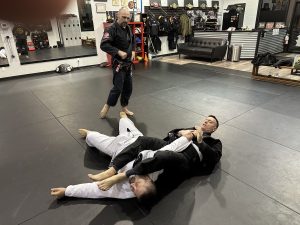White belt requirements
To be a good white belt in Brazilian Jiu Jitsu (BJJ), you should focus on developing foundational skills, understanding basic techniques, and cultivating the right mindset for learning and improvement. Here’s a comprehensive guide on what’s required to excel as a white belt:
1. Develop Fundamental Techniques
Core Techniques
Escapes
- Mount Escape (Upa/Buck and Roll): Escape from being mounted by bridging and rolling.
- Elbow Escape (Shrimping): Escape from mount or side control by creating space and replacing guard.
- Side Control Escape: Basic techniques to regain guard or stand up.
Submissions
- Basic Chokes: Cross collar choke from guard, guillotine.
- Joint Locks: Straight armbar from guard or mount, Americana from side control.
Sweeps
- Scissor Sweep: A basic sweep from closed guard.
- Hip Bump Sweep: A sweep from guard when the opponent postures up.
Guard Work
- Closed Guard: Basic attacks and defenses from closed guard.
- Open Guard: Simple concepts of maintaining open guard and transitioning to other positions.
Positional Control
- Mount: Basic principles of maintaining mount and transitioning between high and low mount.
- Side Control: Understanding the fundamental controls and transitions from side control.
- Back Control: Basics of maintaining back control and applying the rear naked choke.
Transitional Movements
- Guard Passing: Basic guard passes like knee slice and torreando pass.
- Takedowns: Understanding and practicing fundamental takedowns like double-leg and single-leg.

2. Emphasize Positional Awareness
Understand Key Positions
- Top Positions: Mount, side control, knee on belly, back control.
- Bottom Positions: Guard, half guard, turtle position.
- Transitions: Moving between positions effectively and safely.
Positional Hierarchy
- Position Before Submission: Focus on establishing and maintaining a dominant position before attempting submissions.
3. Focus on Basic Concepts and Principles
Leverage and Mechanics
- Base and Balance: Maintaining stability and preventing sweeps or positional losses.
- Frames and Hooks: Using your body effectively to create space and control opponents.
Pressure and Timing
- Apply Pressure: Use body weight to control and wear down opponents.
- Timing: Learn to recognize and exploit opportunities for movement or attacks.
Defense First
- Survival: Prioritize defending against submissions and escaping bad positions.
- Escape Routes: Understand and practice basic escape routes from common positions.
4. Cultivate Good Training Habits
Regular Attendance
- Consistent Training: Attend classes regularly to build muscle memory and familiarity with techniques.
- Drilling: Focus on drilling techniques repetitively to understand their mechanics and applications.
Active Participation
- Ask Questions: Seek clarification from instructors or higher belts when unsure about techniques.
- Engage in Sparring: Participate in controlled sparring to apply techniques and learn from experience.
Respect for Partners
- Safety First: Train safely and respectfully, avoiding unnecessary force.
- Communication: Communicate with training partners, especially during drilling and sparring.
5. Develop a Learning Mindset
Be Humble and Open-Minded
- Accept Feedback: Be open to constructive criticism and use it to improve.
- Learn from Losses: Understand that losses in sparring are learning opportunities.
Patience and Perseverance
- Embrace the Process: Focus on gradual improvement rather than immediate success.
- Stay Positive: Keep a positive attitude and be patient with your progress.
Study and Reflect
- Review Techniques: After class, review what you’ve learned to reinforce knowledge.
- Watch and Learn: Watch instructional videos or matches to gain different perspectives on techniques and strategies.
6. Build Physical Conditioning
Strength and Flexibility
- General Fitness: Maintain a basic level of fitness to support your training.
- Flexibility: Improve flexibility to enhance movement and reduce injury risk.
Endurance
- Cardio: Build cardiovascular endurance to handle the physical demands of rolling.
- Grappling Specific: Engage in conditioning that mimics the movements and demands of BJJ.
7. Understand Etiquette and Culture
Respect Academy Rules
- Gi and Hygiene: Maintain a clean gi and good personal hygiene.
- Punctuality: Arrive on time for classes and participate fully.
Respect Higher Belts and Instructors
- Learning from Others: Respect the experience and knowledge of higher belts and instructors.
- Contribute Positively: Be a supportive and positive member of the academy.
8. Practical Tips for Being a Good White Belt
Record Your Progress
- Training Journal: Keep a journal of techniques learned, sparring insights, and areas for improvement.
- Set Goals: Set short-term and long-term goals for your BJJ journey.
Drill, Drill, Drill
- Repetition: Focus on drilling basic techniques until they become second nature.
- Partner Drills: Pair up with training partners to practice techniques and troubleshoot challenges.
Cross-Train and Supplement
- Explore Related Areas: Consider cross-training in related disciplines like judo or wrestling for additional perspectives on grappling.
- Supplemental Training: Engage in strength training or flexibility routines to complement your BJJ practice.
Final Thoughts
Being a good white belt in BJJ is about building a solid foundation of fundamental techniques, understanding key concepts, and developing good training habits. Focus on learning and improving with a positive and humble mindset, and you’ll set yourself up for long-term success in Brazilian Jiu Jitsu.

